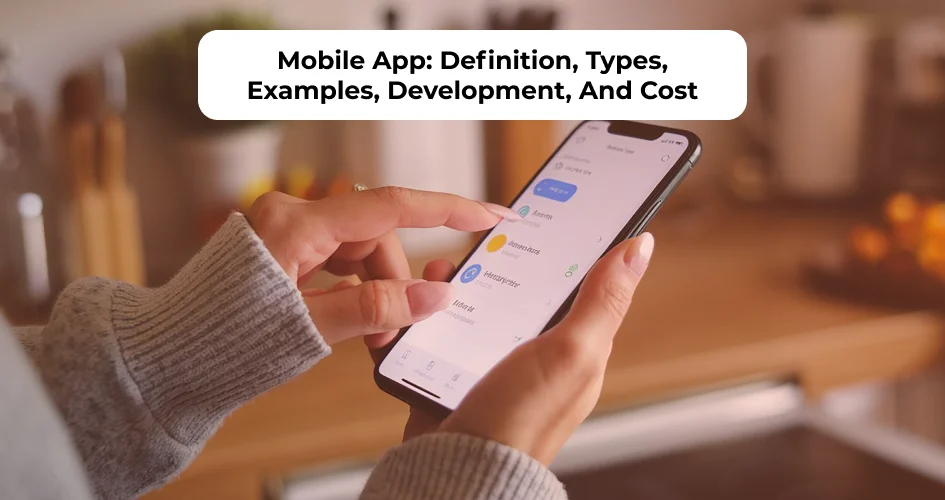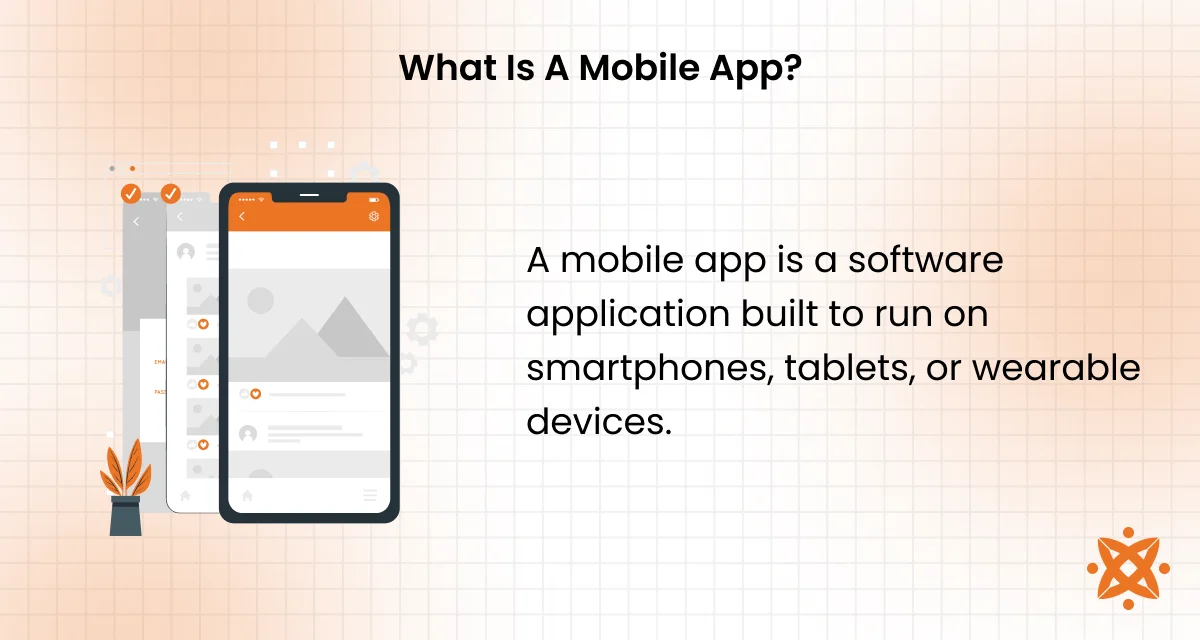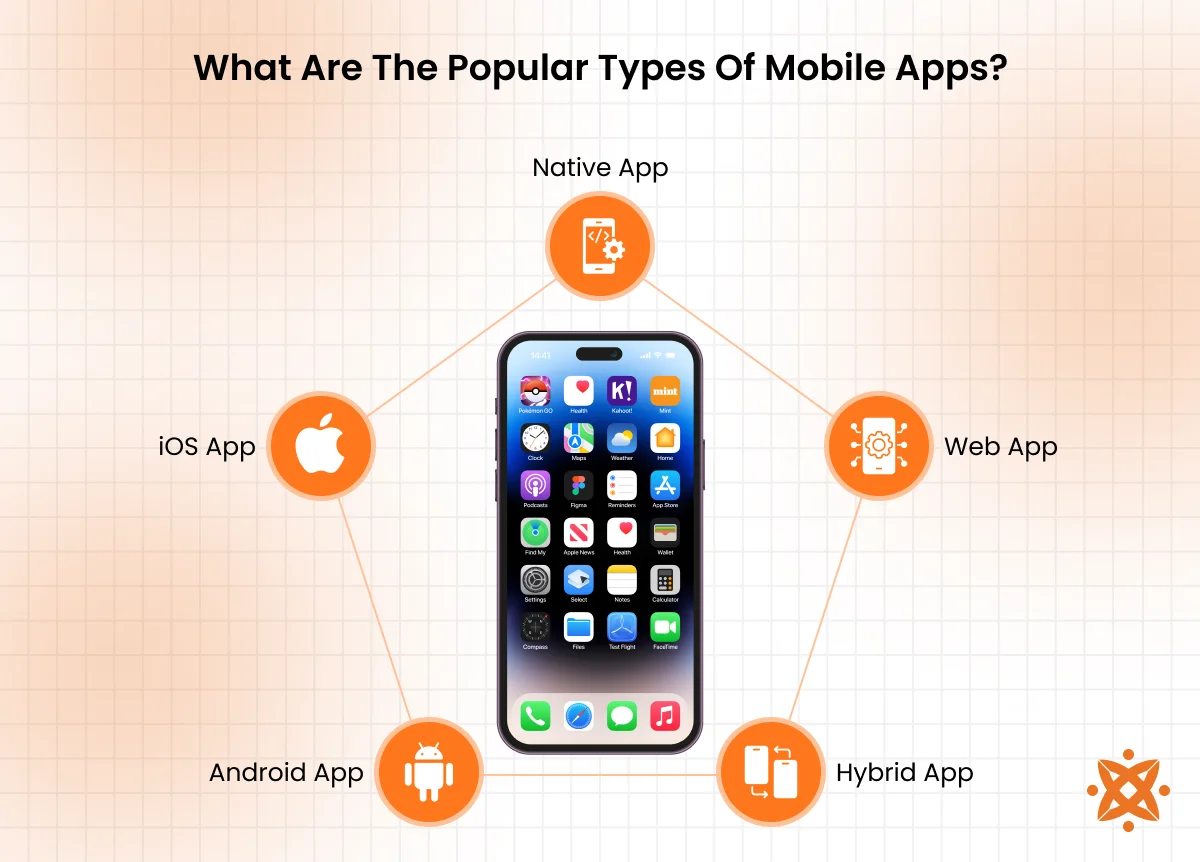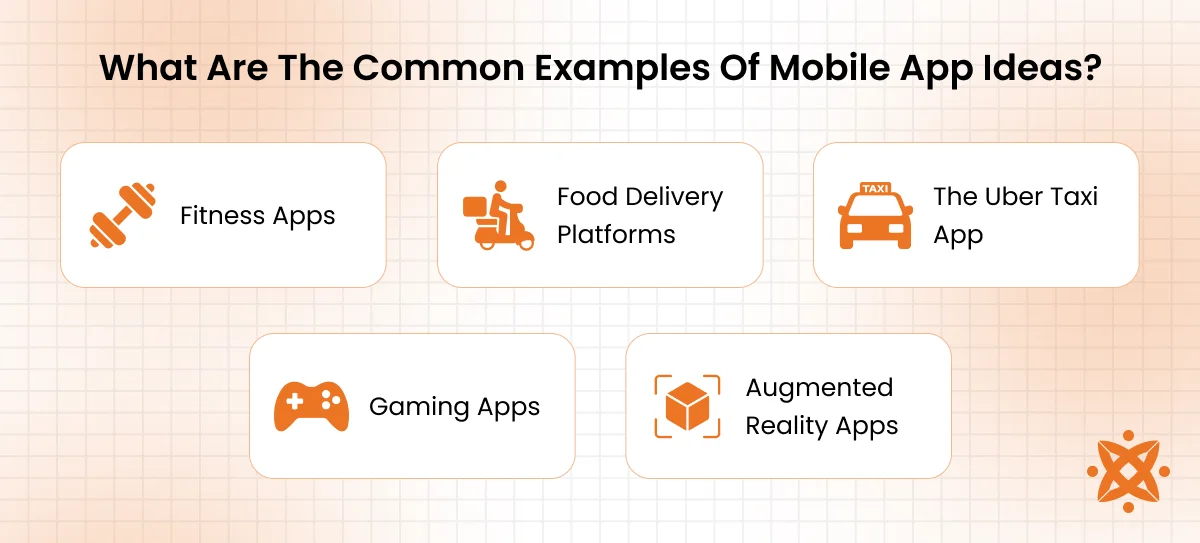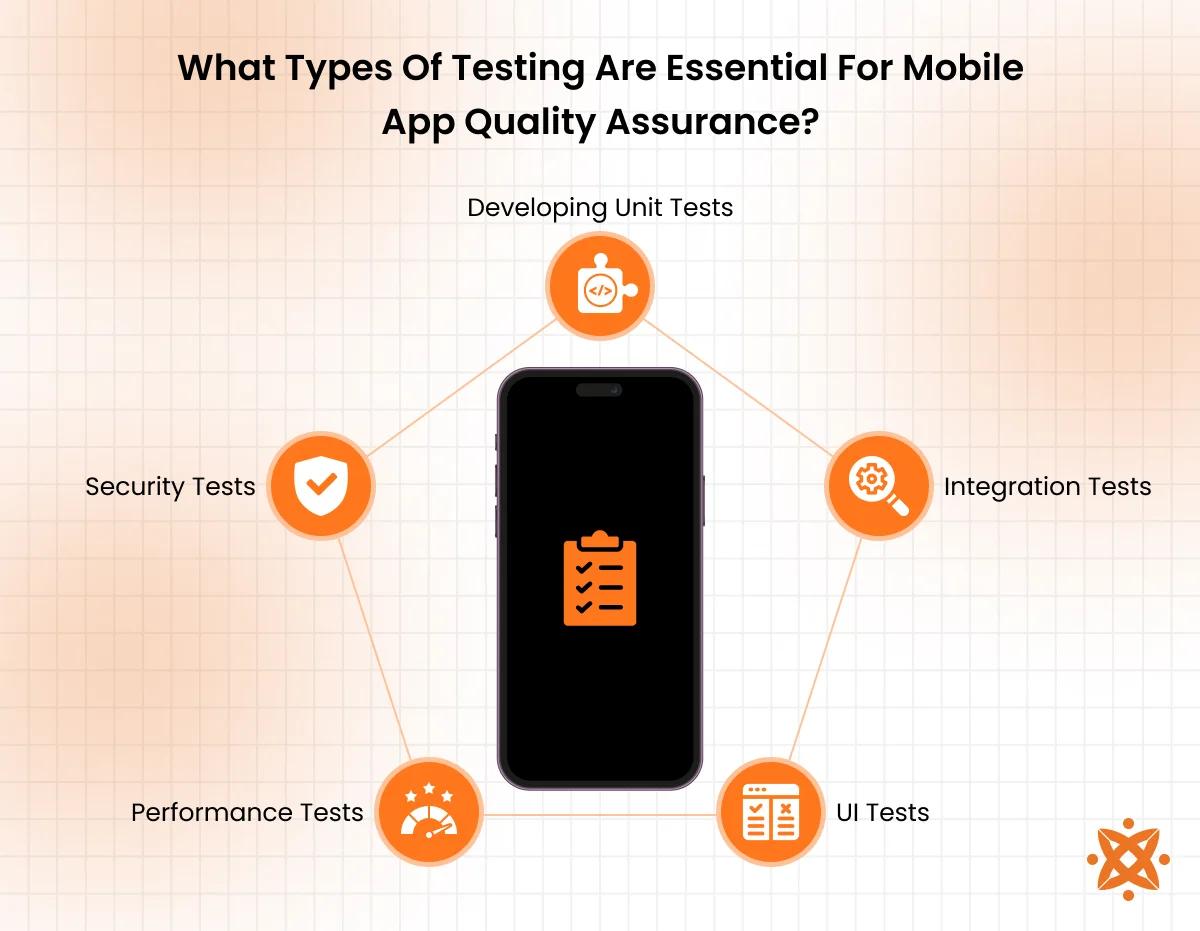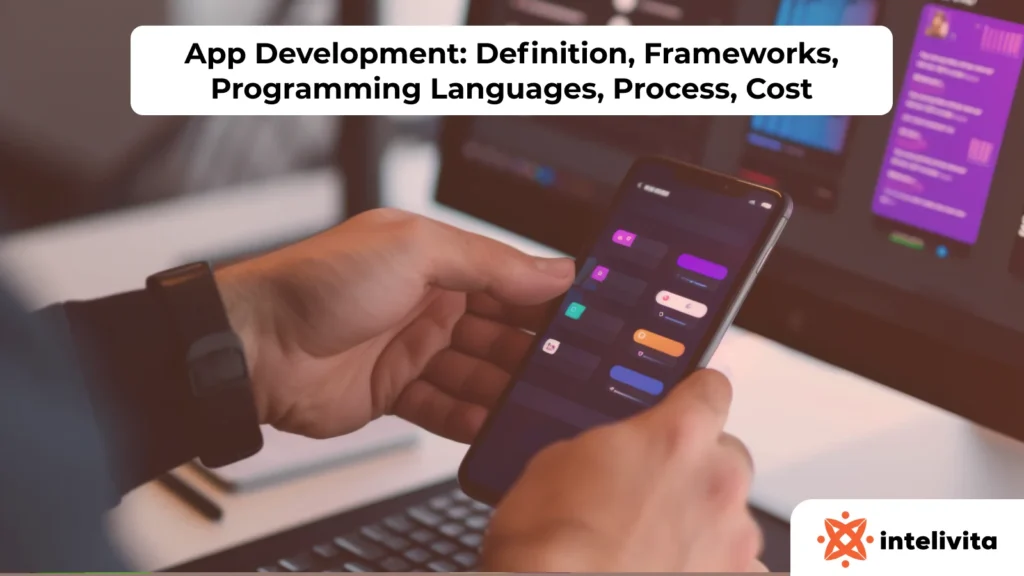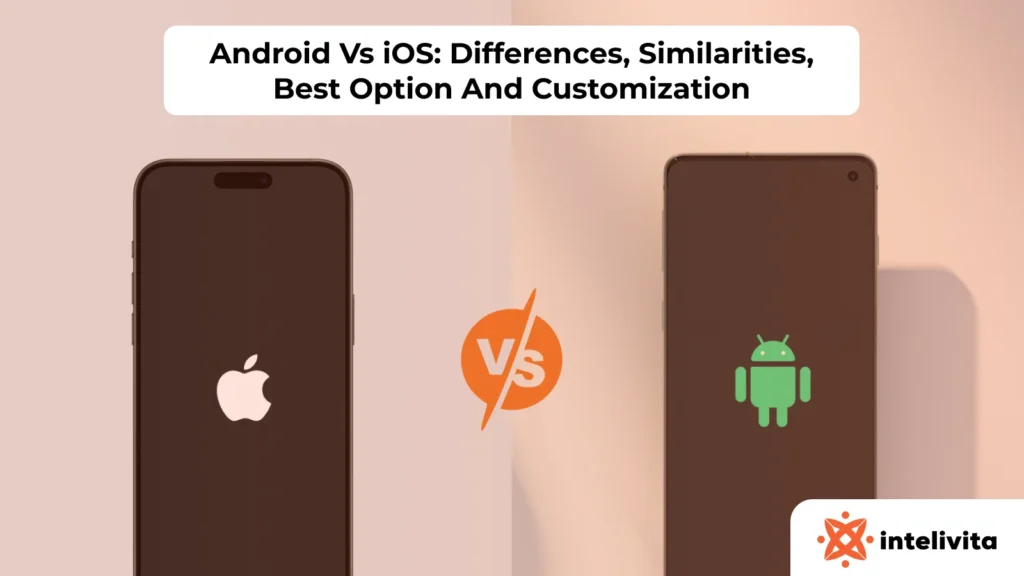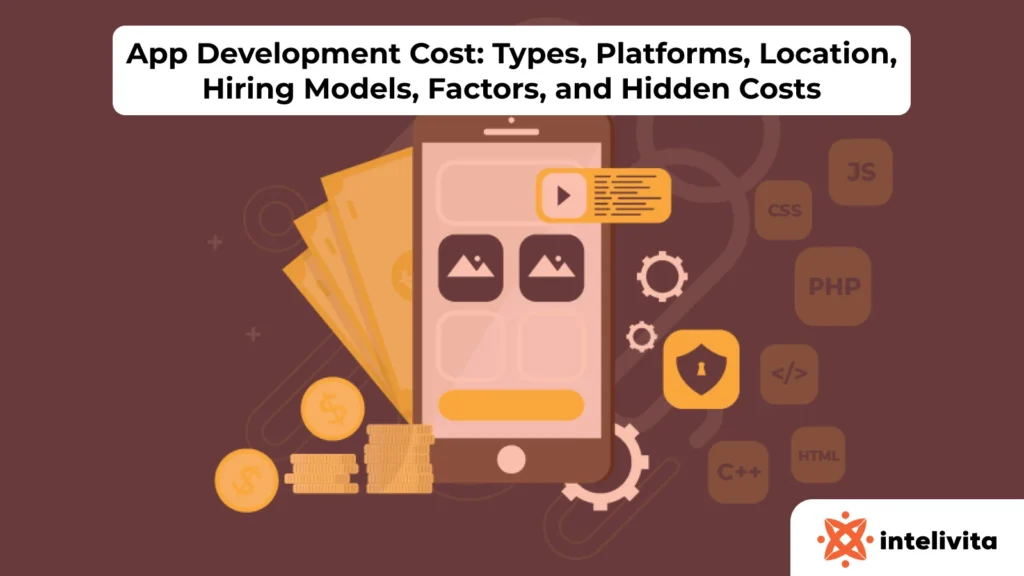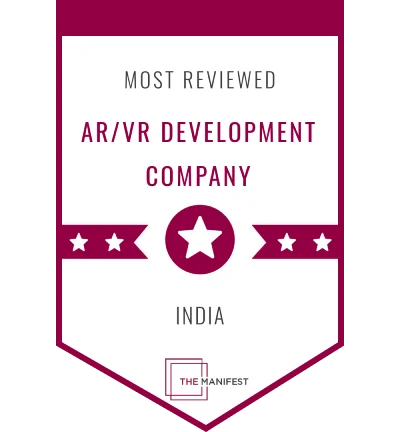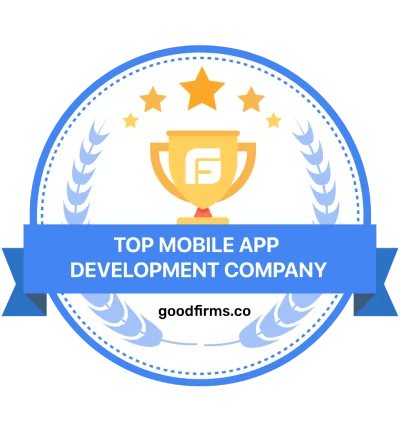A mobile app helps you perform tasks, access services, or interact with content from anywhere. You install it from an app store, use it with touch navigation, and rely on it for everything from banking to entertainment..
The three main types of mobile apps are Android apps, iOS apps, and Windows apps. Each one is designed for a specific operating system using tools that match platform standards. Android apps are built in Kotlin or Java using Android Studio; iOS apps are developed in Swift using Xcode; and Windows apps use C# and UWP within Visual Studio.
The most common mobile app ideas include fitness apps, food delivery platforms, the Uber taxi app, gaming apps, and augmented reality apps. Developers continue to create apps that match changing lifestyles and user habits. Whether you’re tracking workouts, booking a cab, or managing tasks, there’s a mobile app designed for it.
To develop a mobile app for Android, iPhone, and Windows, you plan the app features, select the right tools, write platform-specific or shared code, and test the app before publishing it to each store. These steps align with modern mobile app development and ensure your product runs smoothly across target devices.
Key cost factors in mobile app development include platform choice, feature complexity, UI design, and ongoing testing and support. Platform choice affects cost significantly. A single-platform app for either Android or iOS costs between $10,000 and $13,000, while cross-platform development ranges from $15,000 to $18,000 due to added testing and configuration for multiple systems.
According to a study by Clutch titled “2022 App Development Survey,” 2022 48% of businesses spent over $100,000 on custom app development, with timelines ranging from 3 to 9 months.
What Is A Mobile App?
A mobile app is a software application built to run on smartphones, tablets, or wearable devices. You use it to perform specific tasks such as tracking your fitness, shopping online, navigating maps, or managing finances. Mobile apps are installed through digital stores like the Apple App Store or Google Play Store and are designed for touch-based interaction.
According to a study by Data.ai titled “State of Mobile 2023,” mobile app downloads reached 255 billion in 2022, with users spending an average of 4.8 hours daily in mobile apps across top markets.
The core features of every mobile app include a user interface, backend services, push notifications, data storage, and device integration. These elements work together to deliver speed, ease of use, and a personalized experience.
The benefits of mobile apps include improved access to services, better user engagement, faster transaction times, and enhanced customer support. Businesses use them to stay visible, provide convenience, and collect insights about user behavior.
A mobile app architecture consists of three layers: presentation (UI), business logic, and data access. The frontend handles what you see, while the backend processes information, stores data, and communicates with servers.
Mobile apps are built for platforms such as iOS, Android, and Windows, each requiring specific programming languages and tools. Developers also use cross-platform frameworks to run the same app across different systems.
What Are The Popular Types Of Mobile Apps?
The popular types of mobile apps are native mobile apps, Android apps, iOS apps, Windows apps, web mobile apps, and hybrid mobile apps. Each type is designed to work on specific platforms or devices and serves different user and business needs.
The popular types of mobile apps are as follows:
Native Mobile App
A native mobile app is made specifically for one operating system, such as iOS or Android. You install it from an app store, and it works closely with the device’s hardware and system features.
Native apps are built using Swift or Objective-C for iOS and Kotlin or Java for Android. Developers use official tools like Xcode for Apple and Android Studio for Android to build and test the app.
The pros of native apps are better performance, strong device integration, smoother user experience, and access to all native APIs. The cons of native apps are longer development time and the need to create separate versions for each platform.
Android App
An Android app is designed to run on smartphones and tablets that use the Android operating system. You download it from the Google Play Store or other trusted app marketplaces. These apps are built to support a wide range of screen sizes, hardware types, and manufacturers.
Android apps are created using Kotlin or Java and are developed in Android Studio, the official development tool. They work well with Google services and are favored for their flexibility, open-source support, and wide global reach.
iOS App
An iOS app runs on Apple devices like the iPhone, iPad, or iPod Touch. You access it through the App Store and install it directly onto your device. These apps are known for their performance, consistency, and clean interface.
Developers build iOS apps using Swift or Objective-C in Xcode, Apple’s official development environment. These apps follow Apple’s strict design and privacy guidelines, making them stable and secure for users.
Windows App
A Windows mobile app is designed for smartphones and tablets running the Windows Mobile operating system. While support for these devices has declined, they were once used for email, browsing, and productivity tools.
These apps were built using C# and .NET technologies in tools like Visual Studio. They focused on integration with Microsoft services and were primarily used in business and enterprise settings.
Web Mobile App
A web mobile app runs through your mobile browser instead of being downloaded from an app store. You open it just like a website, but it functions like an app, letting you swipe, scroll, and interact with features.
A web app is built using HTML, CSS, and JavaScript, supported by frameworks like React, Angular, or Vue.js. Developers host these apps on web servers and access them through URLs. Many web apps now follow progressive web app (PWA) standards, which allow features like offline access, push notifications, and fast loading speeds.
The pros of web mobile apps are easy access, no download required, quick updates, and wide device compatibility. The cons are limited access to device features, lower performance compared to native apps, and dependence on an internet connection. Examples include news sites, shopping platforms, and collaboration tools like MS Teams when accessed via a browser.
Hybrid Mobile App
A hybrid mobile app is installed like a native app but built using web technologies. It opens on your phone, but much of what you see and use is powered by code that runs inside a web container.
Hybrid apps are created using HTML, CSS, and JavaScript, with help from frameworks like Ionic, Cordova, or Capacitor. These tools allow developers to build once and deploy the app on both iOS and Android with minimal changes.
The pros of hybrid apps are faster development time, lower cost, and shared code across platforms. The cons are lower performance, limited access to native features, and possible design issues across different devices.
What Are The Common Examples Of Mobile App Ideas?
The most common mobile app ideas include fitness apps, food delivery platforms, the Uber taxi app, gaming apps, and augmented reality apps. These apps are built to solve daily problems, offer on-demand services, or improve how you manage work, health, and communication.
The most common mobile app ideas are explained below:
1. Fitness App
A fitness app helps you stay active, monitor your health, and reach workout goals using your mobile device. You use it to track steps, plan exercises, monitor heart rate, or follow workout routines at home or the gym.
Fitness apps include different categories such as workout planners, step counters, yoga trainers, and nutrition trackers. Examples of fitness apps include apps like Nike Training Club for strength workouts, MyFitnessPal for calorie tracking, and Strava for running and cycling logs. Fitness apps sync with wearables to show real-time data on your phone.
2. Food Delivery App
A food delivery app connects you with restaurants and food services so you order meals directly from your phone. You browse menus, place an order, and track delivery — all within a few taps.
A food delivery app lets you choose from local restaurants, fast food chains, or grocery stores. Some apps offer scheduled deliveries, while others focus on real-time dispatch. Examples include Uber Eats, DoorDash, and Grubhub. These apps also allow in-app payments, delivery tracking, and customer reviews to improve the ordering experience.
3. Uber Taxi App
An Uber-style taxi app helps you request a ride from your phone without calling a driver or waiting on the street. You open the app, enter your destination, and get matched with a nearby driver who arrives in minutes.
An Uber taxi app includes GPS navigation, fare calculation, real-time driver tracking, and payment processing. These apps reduce wait times, offer ride choices, and improve safety with driver profiles and trip sharing. Examples include Uber, Lyft, and Bolt.
4. Gaming App
A gaming app brings entertainment directly to your mobile device. You use it to play solo games, compete with others, or enjoy story-driven adventures anywhere.
A gaming app is a puzzle, action, simulation, or multiplayer experience. Examples include Clash of Clans, Among Us, and Candy Crush. These apps include rewards, social sharing, and in-app purchases to keep players engaged.
5. Sports App
A sports app keeps you updated with real-time scores, match schedules, team news, and player stats. You follow games, set alerts, and watch highlights from your phone.
A sports app focuses on a single league or offers coverage across multiple sports. Examples include ESPN, Bleacher Report, and theScore. These apps also include fantasy leagues, live commentary, and social features for fans.
6. Taxi App
A taxi app works like a digital dispatcher. You request a licensed taxi from your phone, view estimated fares, and track the driver’s arrival.
A taxi app is used in cities where regulated taxis operate alongside ride-sharing services. Examples include Curb, Free Now, and local government-approved services. These apps offer fare transparency and official vehicle options.
7. Augmented Reality App (AR App)
An AR app blends digital elements into your real-world view using your phone’s camera. You point your device, and the app overlays visuals or data onto your environment.
An AR app is used for virtual furniture placement, educational visuals, or gaming. Examples include IKEA Place, Google Lens, and Pokémon GO. These apps rely on camera access, location data, and object detection.
8. Virtual Reality App
A virtual reality app creates a fully immersive digital environment. You wear a VR headset, and the app responds to your movement and gaze.
A virtual reality app is used for gaming, training simulations, and virtual tours. Examples include YouTube VR, Beat Saber, and Wander. These apps offer a 360-degree experience, sound interaction, and hand controls.
9. Social Media App
A social media app helps you connect, share content, and interact with others online. You post updates, follow friends, and react to videos or photos.
A social media app includes features like messaging, story updates, and live streaming. Popular examples are Instagram, Facebook, and TikTok. These apps also support content creation, user discovery, and brand promotion.
10. Finance App
A finance app lets you manage your money directly from your phone. You check balances, track spending, and transfer funds without visiting a bank.
A finance app includes features like budgeting, bill reminders, and investment tools. Examples include Mint, Robinhood, and PayPal. These apps help improve financial planning, security, and access to banking services.
11. Travel Apps
A travel app helps you plan, book, and manage trips using your mobile device. You use it to find flights, reserve hotels, explore destinations, and keep track of your itinerary in one place.
A travel app offers booking tools, offline maps, language tips, and currency converters. Examples include TripIt, Skyscanner, and Booking.com. These apps simplify trip planning and give you access to travel services while on the move.
12. Dating App
A dating app lets you meet new people based on shared interests, location, or preferences. You create a profile, view matches, and connect through messaging or video chat.
A dating app includes swiping features, profile filters, and safety tools. Examples include Tinder, Bumble, and Hinge. These apps are used for casual chats, long-term relationships, or community-based connections.
13. Calculator App
A calculator app gives you quick access to basic or advanced math tools. You use it for everyday calculations like bills, conversions, or budgeting.
A calculator app includes standard functions, scientific modes, or finance-based tools. Examples are Calculator+, RealCalc, and built-in options on Android and iOS. These apps offer fast answers and simple layouts for quick tasks.
14. Weather App
A weather app keeps you informed about temperature, rainfall, wind, and forecasts in your area or any location you choose. You check it before travel, events, or daily planning.
A weather app includes hourly updates, radar maps, and alerts for severe conditions. Examples are AccuWeather, The Weather Channel, and Windy. These apps help you stay prepared and avoid disruptions.
15. Shopify App
A Shopify app helps store owners run their eCommerce business from a mobile device. You manage orders, check inventory, and respond to customers while away from a computer.
A Shopify app connects to your online store and shows real-time data. Examples include the Shopify Mobile App, Shopify POS, and third-party tools that track sales performance. These apps support business operations on the go.
15. Productivity App
A productivity app helps you stay focused, manage your time, and improve your daily workflow. You use it to organize tasks, set reminders, and keep track of deadlines.
A productivity app includes note-taking, calendar integration, or focus timers. Examples include Evernote, Notion, and Trello. These apps are built to reduce distractions and support better time management.
16. Task Manager App
A task manager app lets you organize goals, break them into steps, and mark progress. You use it to keep work and personal tasks under control.
A task manager app includes features like to-do lists, priority labels, and alerts. Examples are Todoist, Microsoft To Do, and Asana. These apps help you stay on schedule and avoid missing important deadlines.
17. Educational App
An educational app helps you learn new subjects, develop skills, or study for exams using your phone or tablet. It offers lessons, quizzes, and videos for users of all ages.
An educational app focuses on school topics, languages, coding, or test preparation. Examples include Duolingo, Khan Academy, and Coursera. These apps let you learn at your own pace with structured content and interactive features.
18. Meditation App
A meditation app guides you through breathing exercises, mindfulness sessions, and relaxation routines. You use it to reduce stress, improve focus, or sleep better.
A meditation app includes audio guides, timers, and progress tracking. Examples are Headspace, Calm, and Insight Timer. These apps support mental wellness and daily mindfulness habits.
19. Health App
A health app helps you monitor physical well-being, track medical records, and maintain healthy habits. It includes features for sleep, heart rate, or symptom checks.
A health app connects with devices or health systems for real-time updates. Examples include Apple Health, Google Fit, and MyChart. These apps bring personal health data to your fingertips for better awareness.
20. Business App
A business app helps you carry out professional tasks from your mobile device. You use it to manage workflows, access reports, monitor performance, or communicate with your team.
A business app focuses on sales tracking, project updates, finance, or document sharing. Examples include Slack for communication, QuickBooks for accounting, and Trello for task management. These tools keep your work organized and accessible outside the office.
21. Note Taking App
A note-taking app gives you a place to store ideas, checklists, and key information. You type, draw, or record voice notes depending on how you prefer to capture content.
A note-taking app includes search tools, cloud sync, and organizational features like folders or tags. Examples include Evernote, OneNote, and Simplenote. These apps help you keep track of details without using paper.
22. Calendar App
A calendar app helps you plan appointments, meetings, and tasks. You use it to block time, receive reminders, and avoid scheduling conflicts.
A calendar app includes features like event sharing, color labels, and daily or monthly views. Popular examples are Google Calendar, Microsoft Outlook Calendar, and Apple Calendar. These apps are built to improve time planning and coordination.
How To Develop A Mobile App For Android, Iphone, And Windows?
To develop a mobile app for Android, iPhone, and Windows, you plan the app features, select the right tools, write platform-specific or shared code, and test the app before publishing it to each store. The process varies slightly across platforms, but the goal remains to build a reliable, user-friendly product that works on target devices.
To develop a mobile app for Android, iPhone, and Windows, the processes involved are explained below:
Android Mobile App Development Process
To develop an Android mobile app, the process involves defining app goals and key features, choosing the technology stack, designing the user interface and experience, developing the app’s core functions, testing the app on multiple devices, and publishing to the Google Play Store. The process focuses on creating a smooth user interface, a strong user experience, and reliable performance across Android devices.
To develop an Android mobile app, the process involved is explained below:
- Define app goals and key features: Outline what the app does, who it serves, and how it solves a problem. This shapes the design and function from the start. Include elements like push notifications, API integrations, and offline access.
- Choose the technology stack: Use Kotlin or Java as the programming language, and build the app in Android Studio. Add libraries for UI design, data handling, and device access.
- Design the user interface and experience: Follow Material Design guidelines for screen flow, navigation, and visuals. Use XML layouts or Jetpack Compose to create responsive designs. Keep menus and actions simple for smooth interactions.
- Develop the app’s core functions: Connect the frontend to backend systems using REST APIs. Handle inputs, process data, and add logic for core features like login, search, or media playback.
- Test the app on multiple devices: Use Android Studio emulators and real devices to check layout, speed, and bugs. Test across screen sizes and Android versions to catch compatibility issues. Include both unit and UI testing tools.
- Publish to the Google Play Store: Prepare assets, write a store listing, and upload your APK or AAB file through the Play Console. Set permissions, pricing, and device availability.
iPhone Mobile App Development Process
To develop an iPhone app, the processes involved are defining app features and purpose, selecting the technology stack, designing the user interface, coding app functions, testing on Apple devices, and submitting to the App Store. These steps ensure the app meets Apple’s guidelines while delivering a strong user experience.
- Defining app features and purpose: Start by outlining what the app does, who uses it, and which problems it solves. Include elements such as push notifications, API integrations, and security settings. This step helps shape the design and function clearly.
- Selecting the technology stack: Use Swift or Objective-C for coding and build the app using Xcode, Apple’s official IDE. Add relevant SDKs for maps, media, or payments depending on your app’s goals.
- Designing the user interface: Follow Apple’s Human Interface Guidelines for layout, navigation, and visual balance. Use SwiftUI or Storyboard to create clean, interactive screens. Keep actions simple and reduce cognitive load.
- Coding app functions: Connect your UI to logic using ViewControllers and backend services. Handle user input, display dynamic data, and integrate with iOS services like Siri or HealthKit. Write code that runs smoothly and loads quickly.
- Testing on Apple devices: Run the app on real iPhones and iPads, as well as using Xcode’s simulators. Use tools like TestFlight to gather feedback from testers. Cover functional, UI, and performance testing.
- Submitting to the App Store: Prepare the app icon, screenshots, and store description. Submit the build through App Store Connect, select pricing, and set age ratings. Follow Apple’s review process for final approval.
Windows Mobile App Development Process
Windows Mobile App Development Process
To develop a Windows mobile app, the processes involved are planning the app’s purpose and features, selecting the technology stack, designing the user interface, developing core functions, testing on Windows devices, and publishing through the Microsoft Store. These steps follow the Windows mobile app development process and ensure compatibility with Microsoft’s mobile environment.
To develop a Windows mobile app, the processes involved are:
- Planning the app’s purpose and features: Begin by defining what the app is meant to do, who it’s for, and how it meets user needs. Include specific functions like push notifications, offline access, and API integrations. This foundation guides every design and development decision.
- Selecting the technology stack: Use C# and .NET Framework within Visual Studio as the core tools. Windows apps also use UWP (Universal Windows Platform) for compatibility across devices. Add SDKs depending on your feature set, such as media, location, or messaging.
- Designing the user interface: Follow Microsoft’s Fluent Design System to build an interface that feels native to Windows. Create screens using XAML and organize them with a clear visual hierarchy. Focus on accessibility, navigation, and responsive design.
- Developing core functions: Write app logic using C# and connect the app to services or local data. Handle navigation, user input, and real-time updates. Secure the app with proper permissions and data encryption.
- Testing on Windows devices: Run the app on actual Windows tablets or emulators provided in Visual Studio. Test for layout issues, performance, and crash handling. Include unit testing and UI testing to cover all functions.
- Publishing through Microsoft Store: Package the app using Visual Studio’s deployment tools. Submit it through the Microsoft Partner Center, providing descriptions, icons, and pricing details. Follow Microsoft’s review steps before release.
Cross-Platform Mobile App Development Process
To develop a cross-platform mobile app, the processes involved are defining shared goals, selecting the technology stack, designing a unified user interface, building shared functionality, testing on multiple devices, and publishing to both app stores. This approach supports the cross-platform mobile app development process while reducing time and code duplication.
To develop a cross-platform mobile app, the processes involved are:
- Defining shared goals: Start by outlining what the app needs to do across all platforms. Identify shared features like push notifications, logins, and API integrations. This helps streamline the development and reduce rework.
- Selecting the technology stack: Use tools like Flutter, React Native, or Xamarin. Write the core logic in Dart, JavaScript, or C#, and choose IDEs like VS Code or Android Studio with cross-platform plugins. These tools support shared development for Android and iOS.
- Designing a unified user interface: Create a layout that works well on both iOS and Android using built-in widgets or components. Keep the user interface consistent while respecting platform-specific patterns. Ensure the design adjusts to different screen sizes.
- Building shared functionality: Write app logic once and connect it to platform APIs as needed. Handle user actions, process data, and store content locally or in the cloud. Keep the structure modular so platform-specific tweaks are easy to apply.
- Testing on multiple devices: Use emulators and real devices for both platforms to check performance, layout, and errors. Apply unit tests and automated UI checks to ensure the app behaves the same way across systems. Testing tools like Appium and Flutter Driver support cross-platform apps.
- Publishing to both app stores: Prepare platform-specific assets like icons and screenshots. Upload the Android build to Google Play Console and the iOS build to App Store Connect. Complete the review steps and manage releases from a single codebase.
What Types Of Testing Are Essential For Mobile App Quality Assurance?
The types of testing essential for mobile app quality assurance include developing unit tests, integration tests, UI tests, performance tests, and security tests. These tests help ensure your app works correctly, handles data safely, and delivers a smooth experience across devices.
The types of testing essential for mobile app quality assurance are:
- Developing unit tests: Test each function or component in isolation to catch errors early. This improves code quality and makes debugging easier. Use tools like JUnit, XCTest, or Mockito.
- Integration tests: Check how different parts of the app work together, such as backend connections or third-party APIs. This helps verify that services and internal components interact correctly. It’s especially useful for apps with login, payment, or syncing features.
- UI tests: Test user flows, button clicks, and navigation to ensure the app behaves as expected. UI tests simulate user behavior and check how the app responds to different screen sizes. Tools like Appium, Espresso, and XCUITest are used.
- Performance tests: Measure how the app performs under various conditions, such as low network speed or high user load. These tests track load time, battery usage, and memory use. They help identify slowdowns before launch.
- Security tests: Check for weak authentication, data leaks, and improper permissions. Security testing is important for apps handling user data, payments, or health records. Use static and dynamic scanning tools to find and fix risks.
Mobile app testing ensures your app is safe, stable, and ready for users. It reduces risk, improves speed, and helps you catch issues before they affect real users. Testing is not just a final step; it’s an ongoing process built into every stage of development.
What Is The Cost Of Developing A Mobile App?
The cost of developing a mobile app is between $10,000 and $18,000, depending on the app’s complexity, features, and development approach. Simple apps with basic functions fall at the lower end, while multi-platform apps with custom UI, backend integrations, and third-party services move toward the higher range.
One major cost factor is platform choice. Developing for one platform (iOS or Android) costs between $10,000 and $13,000, while cross-platform apps typically range from $15,000 to $18,000 due to shared code but added testing effort. Supporting both iOS and Android natively exceeds $18,000.
The next factor is feature complexity. Apps with standard features (login, profile, settings) stay around $10,000 to $13,000, while advanced features like real-time chat, geolocation, or video calls increase the cost to $18,000 or more. Backend infrastructure, such as cloud storage or analytics tools, adds $3,000 to $5,000, depending on scale.
UI/UX design contributes around $2,000 to $5,000, based on the number of screens and animations. Testing and QA add $1,500 to $25,00, while post-launch support and maintenance typically costs 15%-20% of the original development budget annually.
What Is The Difference Between A Mobile App And A Web App?
The difference between a mobile app and a web app is that a mobile app is installed directly on a device, while a web app runs through a browser and doesn’t require installation. Mobile apps are built for specific platforms like iOS or Android, using native or cross-platform code, and access device features like GPS, camera, and offline storage.
A web app, on the other hand, is accessed via a URL and built using web technologies such as HTML, CSS, and JavaScript. It relies on internet connectivity and runs inside a browser, offering fewer device integrations. While mobile apps generally offer better performance and user experience, web apps are easier to update and maintain.
What Is The Difference Between A Mobile App And A Progressive Web App?
The difference between a mobile app and a progressive web app is that a mobile app is downloaded from an app store and installed on your device, while a progressive web app (PWA) is accessed through a browser but behaves like a native app. Mobile apps are built using platform-specific or cross-platform code and fully integrate with device hardware and system services.
A PWA uses standard web technologies such as HTML, CSS, and JavaScript but adds capabilities like offline access, push notifications, and home screen installation. While mobile apps offer deeper performance and customization, PWAs are easier to develop and deploy across devices without needing separate builds for each platform.
What Is The Difference Between A Mobile App And A Desktop App?
The difference between a mobile app and a desktop app is that a mobile app is built for handheld devices like smartphones and tablets, while a desktop app is designed to run on computers or laptops with larger screens and different input systems.
Mobile apps focus on touch interfaces, mobility, and battery efficiency, whereas desktop apps are optimized for keyboard and mouse input, more processing power, and multi-window environments.
A secondary difference lies in development tools and usage patterns. Mobile apps are developed using mobile SDKs and deployed through app stores, while desktop apps use frameworks like Electron, .NET, or Java and are distributed through direct downloads or platforms like Microsoft Store.
Desktop apps usually offer more processing capabilities, while mobile apps prioritize portability and convenience.
What Are The Common Mobile App Vulnerabilities?
The common mobile app vulnerabilities are insecure data storage, weak authentication, and poor encryption. These flaws expose user information to unauthorized access, especially when data is stored on the device without proper protection or transmitted without secure protocols.
Secondary vulnerabilities include insecure API integrations, improper session handling, and outdated libraries. These issues allow attackers to exploit weak points in third-party services or intercept user sessions.
According to a report by OWASP, insecure data storage and broken authentication are among the top risks in mobile app security, leading to data leaks and privacy violations.
What Are The Best Practices For Designing Intuitive Mobile App Interfaces?
The best practices for designing intuitive mobile app interfaces are prioritizing simplicity, clarity, and user flow. A clear layout with minimal steps helps users accomplish tasks without confusion. Buttons, menus, and actions should be easy to identify and follow a consistent design pattern across the app.
Secondary best practices include using platform-specific design guidelines, ensuring accessibility, and optimizing for different screen sizes. Following standards like Apple’s Human Interface Guidelines or Google’s Material Design improves user experience.
Adding support for screen readers, readable fonts, and proper color contrast ensures that your app is usable by a wider audience.
What Are The Best Mobile App Design Builders?
The best mobile app design builders are Figma, Adobe XD, and Sketch. These tools allow you to create high-quality wireframes, interactive prototypes, and collaborative design systems with precision. They support team collaboration, version tracking, and plugins for design-to-code transitions.
Secondary design builders include InVision, Framer, and UXPin, which focus on user testing, animations, and smooth handoff to developers. These platforms are used for creating responsive designs, gathering feedback, and integrating directly into the mobile app development process. Each builder supports platform-specific templates to streamline UI planning for iOS and Android.
Can You Develop A Mobile App With Python?
Yes, you can develop a mobile app with Python by using frameworks that bridge Python code with native components. Tools like Kivy, BeeWare, and PyQt allow you to build cross-platform apps with Python, supporting both Android and iOS. While Python is not native to mobile systems, these frameworks convert Python scripts into formats mobile devices understand.
Python is commonly used for backend logic, data processing, or as a scripting layer within hybrid apps. However, performance and native integration are limited compared to languages like Swift or Kotlin. Still, Python remains a practical choice for prototypes, internal tools, and apps that rely on data-heavy operations.
What Are The Requirements For Developing A Mobile App?
The requirements for developing a mobile app are a clear project scope, target platform selection, and the right development tools. You need to define what the app does, who it serves, and which devices it runs on. This includes choosing between native, hybrid, or cross-platform development based on goals and budget.
Secondary requirements include a skilled development team, UI/UX design assets, testing devices, and backend infrastructure. You also need to plan for API integrations, security protocols, and store compliance. These elements ensure your app functions properly, looks professional, and meets platform-specific standards.
How To Choose A Mobile App Development Company In The USA?
To choose a mobile app development company in the USA, consider their experience with iOS and Android apps, portfolio quality, and client reviews. A company with proven results across native, hybrid, and cross-platform mobile app development better meets your technical and strategic needs. Reviewing past projects shows their ability to deliver user-focused, stable, and well-designed apps.
Secondary factors include communication practices, pricing transparency, and post-launch support. The right company offers clear timelines, regular updates, and long-term maintenance options. It’s also important to check if the mobile app development company follows USA data protection laws and has expertise in relevant sectors like eCommerce, healthcare, or finance.
What Are The Qualifications For A Mobile App Developer?
The qualifications for a mobile app developer include proficiency in programming languages like Swift, Kotlin, Java, or JavaScript, and experience with mobile frameworks. Developers should also understand UI/UX principles, API usage, and how to build apps for both Android and iOS platforms. Hands-on experience with tools like Xcode, Android Studio, or cross-platform environments is vital.
Additional qualifications for mobile app developers include knowledge of testing frameworks, version control systems like Git, and app store submission processes. Many developers also hold certifications in mobile technologies or computer science degrees.
Strong problem-solving skills and understanding of mobile app accessibility standards further increase a developer’s ability to build inclusive and reliable apps.
What Are The Main Monetization Models For Mobile Apps?
The main monetization models for mobile apps include in-app purchases, subscription plans, in-app advertising, and paid downloads. These models allow developers and businesses to generate revenue based on how users interact with or access the app.
In-app purchases and subscriptions are widely used in fitness, education, and streaming apps, offering premium features or exclusive content.
Secondary models include freemium access, sponsorships, and affiliate marketing. Freemium apps provide basic functionality for free with optional upgrades, while sponsored content or affiliate links bring in income without charging users.
Choosing the right model depends on your target audience, app category, and long-term engagement strategy.
What Privacy Regulations Must Mobile Apps Comply With?
The privacy regulations mobile apps must comply with include GDPR (General Data Protection Regulation), CCPA (California Consumer Privacy Act), and data security standards like ISO/IEC 27001.
These rules require apps to inform users about data collection, get user consent, and secure personal data during storage and transmission. Apps must also allow users to access, modify, or delete their data when requested.
Additional compliance involves HIPAA for healthcare apps in the U.S. and PECR in the UK for apps that use cookies or send marketing communications. Mobile apps targeting global users must address multiple legal frameworks to avoid penalties and build user trust through transparent privacy practices.
How Does 5 G Technology Enhance Mobile App Capabilities?
The ways 5G technology enhances mobile app capabilities include faster data speeds, lower latency, and improved network capacity. These upgrades allow apps to deliver high-definition video, real-time communication, and smooth cloud interactions without delays. For example, streaming apps load instantly, and multiplayer games respond more fluidly under 5G networks.
Additional improvements include enhanced performance for augmented reality, virtual reality, and Internet of Things (IoT) apps. 5G supports larger user bases, more device connections, and real-time analytics, enabling developers to create richer experiences. This advancement helps apps evolve into more immersive, intelligent, and scalable platforms.

